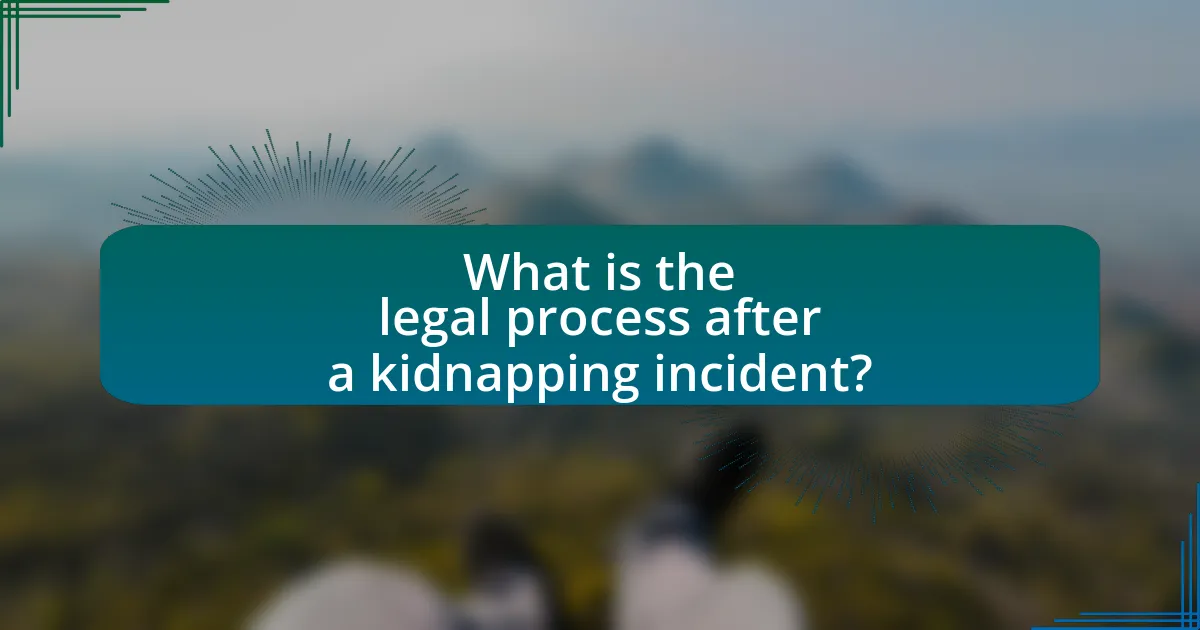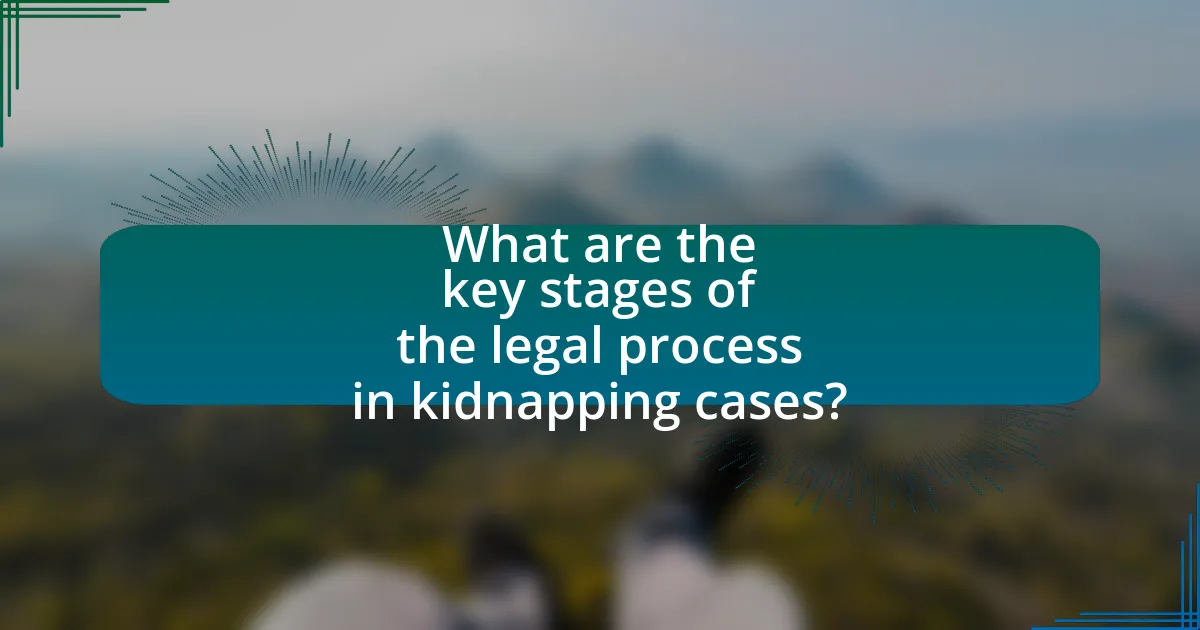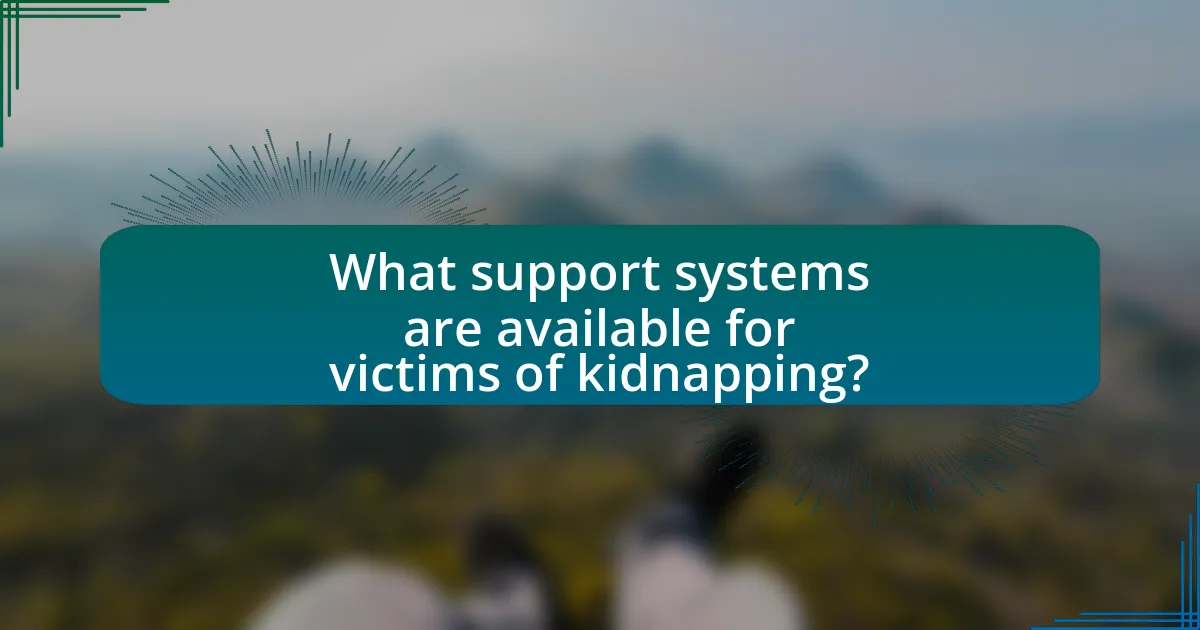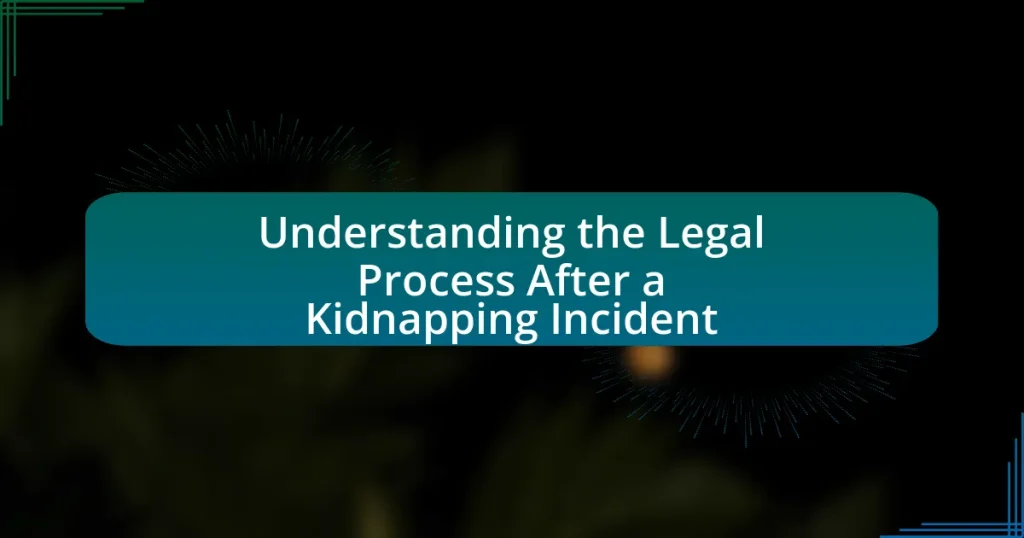The article focuses on the legal process following a kidnapping incident, detailing the steps taken by law enforcement from the initial report to the prosecution of suspects. It defines kidnapping in legal terms, outlines various types of kidnapping, and explains how jurisdictional differences can affect legal definitions and consequences. The article also discusses the investigation phase, the roles of emergency services, and the legal actions available to victims and their families, including civil lawsuits and victim compensation programs. Additionally, it highlights the psychological support systems available for victims and best practices for families navigating the aftermath of a kidnapping.

What is the legal process after a kidnapping incident?
The legal process after a kidnapping incident typically begins with the immediate reporting of the crime to law enforcement authorities. Once reported, police initiate an investigation, which may involve gathering evidence, interviewing witnesses, and locating the victim. Following the investigation, if sufficient evidence is found, law enforcement may arrest the suspect(s) involved in the kidnapping.
Subsequently, the case is referred to the prosecutor’s office, where charges are formally filed against the accused. The legal proceedings then move to court, where the accused may face arraignment, pre-trial hearings, and ultimately a trial. If convicted, the perpetrator may face severe penalties, including imprisonment, as dictated by state or federal laws regarding kidnapping.
This process is supported by legal frameworks that define kidnapping and outline the rights of victims and the responsibilities of law enforcement, ensuring that justice is pursued effectively.
How is a kidnapping defined in legal terms?
Kidnapping is legally defined as the unlawful taking and carrying away of a person by force or fraud. This definition encompasses various elements, including the intent to deprive the individual of their liberty and the use of coercive means to achieve this. In many jurisdictions, kidnapping is classified as a felony, reflecting its severity and the potential harm to the victim. Legal statutes often specify that the act can involve the abduction of a person against their will, and may include additional factors such as the victim’s age or the circumstances surrounding the abduction, which can influence the charges and penalties involved.
What are the different types of kidnapping recognized by law?
The different types of kidnapping recognized by law include simple kidnapping, aggravated kidnapping, and parental kidnapping. Simple kidnapping involves unlawfully seizing and carrying away a person, typically without the use of force or threats. Aggravated kidnapping involves additional factors such as the use of a weapon, causing bodily harm, or the intent to commit another crime, which elevates the severity of the offense. Parental kidnapping occurs when a parent unlawfully takes or keeps their child away from the other parent or legal guardian, violating custody agreements or court orders. These classifications are established in various legal statutes and can vary by jurisdiction, reflecting the seriousness and circumstances surrounding each case.
How do jurisdictional differences affect kidnapping definitions?
Jurisdictional differences significantly affect kidnapping definitions by varying the legal criteria and elements that constitute the crime. For instance, some jurisdictions may define kidnapping strictly as the unlawful taking and carrying away of a person, while others may include elements such as intent to hold for ransom or to inflict harm. Additionally, the age of the victim can influence definitions; certain jurisdictions may have specific statutes for the abduction of minors that differ from those for adults. These variations can lead to different legal consequences and enforcement practices, as seen in the United States where state laws differ widely, resulting in discrepancies in prosecution and sentencing for similar acts of kidnapping.
What initial steps are taken following a kidnapping report?
Following a kidnapping report, law enforcement agencies initiate a series of critical steps to address the situation. First, they confirm the validity of the report by gathering essential information from the victim’s family or witnesses, which includes details about the victim, the circumstances of the kidnapping, and any potential suspects. Next, law enforcement mobilizes resources, including specialized units such as SWAT or K-9 teams, to conduct immediate searches in the area where the kidnapping occurred. Additionally, they issue alerts, such as Amber Alerts, to inform the public and solicit assistance in locating the victim. These actions are crucial as they aim to ensure the safety of the victim and facilitate a swift response to apprehend the perpetrators.
How do law enforcement agencies respond to a kidnapping report?
Law enforcement agencies respond to a kidnapping report by immediately initiating an investigation, which includes gathering information from the victim’s family, witnesses, and any available surveillance footage. They prioritize the safety of the victim and may deploy specialized units, such as SWAT or K-9 teams, to assist in the search. According to the FBI, the first 48 hours are critical in kidnapping cases, as the likelihood of recovery decreases significantly after this period. Agencies also coordinate with local, state, and federal resources to enhance their response capabilities, ensuring a comprehensive approach to resolving the incident.
What role do emergency services play in the immediate aftermath?
Emergency services play a critical role in the immediate aftermath of a kidnapping incident by providing essential support, including medical assistance, search and rescue operations, and securing the scene. Their prompt response is vital for assessing the health and safety of the victim, as well as gathering evidence that may be crucial for legal proceedings. For instance, emergency medical technicians (EMTs) are trained to stabilize victims and transport them to medical facilities, while law enforcement agencies initiate investigations to locate suspects and prevent further harm. The effectiveness of emergency services in these situations is underscored by their established protocols and training, which are designed to address the complexities of such traumatic events.
What legal actions can victims and families pursue after a kidnapping?
Victims and families can pursue several legal actions after a kidnapping, including filing criminal charges against the perpetrator, seeking civil lawsuits for damages, and applying for victim compensation programs. Criminal charges can lead to prosecution under state or federal laws, which may result in imprisonment for the offender. Civil lawsuits allow victims to seek financial compensation for emotional distress, medical expenses, and other damages incurred due to the kidnapping. Additionally, many states have victim compensation programs that provide financial assistance to cover costs related to the crime, such as counseling and lost wages. These legal avenues are supported by laws that protect victims’ rights and provide mechanisms for accountability and restitution.
What are the options for filing a civil lawsuit?
The options for filing a civil lawsuit include initiating a lawsuit in a state court, pursuing mediation or arbitration, and filing a complaint in federal court if federal jurisdiction applies. Initiating a lawsuit in a state court typically involves drafting and filing a complaint that outlines the claims against the defendant, while mediation or arbitration offers alternative dispute resolution methods that can be less formal and quicker than traditional litigation. Filing in federal court is applicable when the case involves federal laws or parties from different states with claims exceeding a specific monetary threshold. Each option provides a structured pathway for individuals seeking legal redress following a kidnapping incident.
How can victims seek restitution or compensation?
Victims can seek restitution or compensation through legal avenues such as filing a civil lawsuit against the perpetrator or applying for state victim compensation programs. Civil lawsuits allow victims to claim damages for losses incurred due to the crime, including medical expenses, lost wages, and emotional distress. State victim compensation programs provide financial assistance to victims for specific expenses related to the crime, such as counseling and medical care, often funded by fines paid by convicted offenders. These processes are supported by laws that aim to ensure victims receive support and justice following criminal acts.

What are the key stages of the legal process in kidnapping cases?
The key stages of the legal process in kidnapping cases include investigation, arrest, arraignment, pre-trial motions, trial, and sentencing. Initially, law enforcement conducts an investigation to gather evidence and identify suspects. Following this, an arrest is made based on probable cause. The suspect is then arraigned, where charges are formally presented, and a plea is entered. Pre-trial motions may occur to address legal issues before the trial begins. The trial stage involves presenting evidence and arguments before a judge or jury. Finally, if the defendant is found guilty, sentencing occurs, determining the punishment based on the severity of the crime and applicable laws. These stages are critical in ensuring justice is served and the legal rights of all parties are upheld.
How does the investigation phase unfold?
The investigation phase unfolds through a systematic process initiated by law enforcement agencies following a kidnapping incident. Initially, officers gather evidence at the crime scene, including physical evidence, witness statements, and surveillance footage. This evidence collection is crucial as it helps establish timelines and identify potential suspects.
Subsequently, investigators conduct interviews with the victim, witnesses, and family members to gather more information about the circumstances surrounding the kidnapping. They also analyze any digital evidence, such as phone records or social media activity, to trace the victim’s last known movements and interactions.
Throughout this phase, law enforcement collaborates with various agencies, including forensic teams and specialized units, to enhance the investigation’s effectiveness. The culmination of these efforts is the development of leads that guide the search for the victim and the apprehension of the perpetrator. This structured approach is essential for ensuring a thorough investigation and increasing the likelihood of a successful resolution.
What evidence is typically collected during a kidnapping investigation?
During a kidnapping investigation, evidence typically collected includes physical evidence, witness statements, digital evidence, and forensic evidence. Physical evidence may consist of items left at the scene, such as clothing or personal belongings of the victim or suspect. Witness statements provide accounts from individuals who may have seen or heard something relevant to the case. Digital evidence encompasses data from phones, computers, or surveillance cameras that can track movements or communications. Forensic evidence involves biological samples, fingerprints, or DNA that can link a suspect to the crime. Collectively, these types of evidence are crucial for establishing timelines, identifying suspects, and supporting legal proceedings.
How do investigators collaborate with other agencies?
Investigators collaborate with other agencies through information sharing, joint task forces, and coordinated operations. This collaboration is essential for pooling resources, expertise, and intelligence, particularly in complex cases like kidnappings. For instance, the FBI often partners with local law enforcement agencies to enhance investigative capabilities and ensure a comprehensive approach to solving cases. Such collaborations can lead to more effective strategies, as evidenced by the success of multi-agency efforts in high-profile kidnapping cases, where combined resources have resulted in quicker resolutions and the safe recovery of victims.
What happens during the prosecution of a kidnapping case?
During the prosecution of a kidnapping case, the state or federal government brings charges against the alleged kidnapper based on evidence gathered during the investigation. The process begins with the filing of formal charges, followed by arraignment, where the defendant enters a plea. Subsequently, pre-trial motions may occur, addressing legal issues before trial, such as the admissibility of evidence. The prosecution presents its case during the trial, which includes witness testimonies and physical evidence. If the jury finds the defendant guilty, sentencing follows, which can include significant prison time, as kidnapping is often classified as a felony. The prosecution relies on statutes that define kidnapping and the severity of penalties, reinforcing the legal framework surrounding such cases.
What charges can be brought against a kidnapper?
Charges that can be brought against a kidnapper typically include kidnapping, unlawful restraint, and false imprisonment. Kidnapping is defined as the unlawful taking and carrying away of a person by force or fraud, which can lead to felony charges. Unlawful restraint involves restricting a person’s freedom of movement without legal authority, while false imprisonment refers to the intentional confinement of a person against their will. These charges can vary by jurisdiction, but they are generally serious offenses that carry significant penalties, including imprisonment.
How does the trial process work in kidnapping cases?
The trial process in kidnapping cases involves several key stages, including pre-trial motions, jury selection, the presentation of evidence, and jury deliberation. Initially, the prosecution files charges, and the defendant may enter a plea. During pre-trial, motions can be made to suppress evidence or dismiss charges. Jury selection follows, where potential jurors are questioned to ensure impartiality.
Once the trial begins, the prosecution presents its case first, introducing evidence and witnesses to establish the defendant’s guilt. The defense then has the opportunity to present its case, which may include evidence and witnesses to counter the prosecution’s claims. After both sides have presented their arguments, the jury deliberates to reach a verdict.
This process is governed by legal standards and procedures to ensure a fair trial, as outlined in the Sixth Amendment of the U.S. Constitution, which guarantees the right to a speedy and public trial by an impartial jury.
What are the potential outcomes of a kidnapping trial?
The potential outcomes of a kidnapping trial include conviction, acquittal, or a plea deal. A conviction can result in significant prison time, often ranging from several years to life imprisonment, depending on the severity of the crime and jurisdictional laws. An acquittal means the defendant is found not guilty, leading to their release. A plea deal may involve the defendant pleading guilty to lesser charges in exchange for a reduced sentence, which is common in many criminal cases to expedite the legal process. These outcomes are influenced by factors such as evidence presented, witness testimonies, and the effectiveness of legal representation.
What sentencing options are available for convicted kidnappers?
Convicted kidnappers face a range of sentencing options, including imprisonment, fines, probation, and restitution. The length of imprisonment can vary significantly based on jurisdiction and the severity of the crime, often ranging from several years to life in prison. For instance, in many states, kidnapping can be classified as a felony, leading to harsher penalties. Additionally, fines may be imposed as part of the sentence, and probation can be an option for less severe cases, allowing the offender to serve their sentence under supervision rather than in prison. Restitution may also be ordered to compensate the victim for damages incurred during the kidnapping.
How can victims impact sentencing decisions?
Victims can significantly impact sentencing decisions through victim impact statements, which allow them to express the emotional, physical, and financial effects of the crime. These statements are often considered by judges during sentencing, as they provide insight into the harm caused and can influence the severity of the sentence. Research indicates that when victims articulate their experiences, it can lead to longer sentences for offenders, as courts aim to acknowledge the suffering endured by victims. For instance, a study published in the “Journal of Criminal Justice” found that victim statements can sway judicial discretion, resulting in harsher penalties in cases where the emotional toll is clearly conveyed.

What support systems are available for victims of kidnapping?
Victims of kidnapping can access various support systems, including law enforcement agencies, mental health services, legal assistance, and victim advocacy organizations. Law enforcement agencies provide immediate safety and investigation support, while mental health services offer counseling and psychological support to help victims cope with trauma. Legal assistance is available to navigate the legal process, including obtaining restraining orders or pursuing civil claims. Victim advocacy organizations, such as the National Center for Victims of Crime, provide resources, support groups, and guidance on rights and available services. These systems work collaboratively to ensure comprehensive support for victims during their recovery and legal proceedings.
How can victims access legal assistance?
Victims can access legal assistance by contacting local legal aid organizations, which provide free or low-cost legal services. These organizations often specialize in helping victims of crimes, including kidnapping, and can guide them through the legal process, including filing reports and obtaining protective orders. Additionally, victims can reach out to state bar associations, which may offer referral services to attorneys who have experience in handling cases related to kidnapping and victim rights. Legal assistance hotlines are also available in many areas, providing immediate support and resources for victims seeking legal help.
What resources are available for finding legal representation?
Resources for finding legal representation include state and local bar associations, legal aid organizations, and online legal directories. State and local bar associations provide referrals to qualified attorneys based on specific legal needs, ensuring that individuals can find representation suited to their case. Legal aid organizations offer free or low-cost legal services to those who qualify, particularly beneficial for individuals facing financial constraints. Online legal directories, such as Avvo or FindLaw, allow users to search for attorneys by practice area and location, providing reviews and ratings to assist in making informed choices. These resources collectively facilitate access to legal representation, particularly in complex situations like those arising from a kidnapping incident.
How do victim advocacy groups assist in the legal process?
Victim advocacy groups assist in the legal process by providing support, resources, and guidance to victims throughout their legal journey. These organizations help victims understand their rights, navigate the complexities of the legal system, and access necessary services such as counseling and legal representation. For instance, studies show that victims who engage with advocacy groups report higher satisfaction with the legal process and better emotional outcomes, indicating the effectiveness of these groups in facilitating a smoother legal experience.
What psychological support is available for kidnapping victims?
Psychological support for kidnapping victims includes trauma-focused therapy, counseling services, and support groups. Trauma-focused therapy, such as Cognitive Behavioral Therapy (CBT), helps victims process their experiences and develop coping strategies. Counseling services provide a safe space for victims to express their feelings and work through emotional distress. Support groups offer community and shared experiences, which can reduce feelings of isolation. Research indicates that these forms of psychological support significantly improve recovery outcomes for victims, as evidenced by studies showing reduced symptoms of PTSD and anxiety in individuals who engage in these therapeutic interventions.
How can therapy and counseling aid in recovery?
Therapy and counseling can significantly aid in recovery by providing emotional support and coping strategies for individuals affected by traumatic experiences, such as kidnapping. These therapeutic interventions help individuals process their trauma, reduce symptoms of anxiety and depression, and rebuild their sense of safety and trust. Research indicates that trauma-focused therapy can lead to improved mental health outcomes, with studies showing that individuals who engage in therapy after traumatic events report lower levels of post-traumatic stress disorder (PTSD) symptoms and better overall psychological well-being.
What community resources are available for emotional support?
Community resources available for emotional support include local mental health organizations, support groups, and hotlines. These resources provide counseling, peer support, and crisis intervention services tailored to individuals affected by traumatic events, such as kidnapping incidents. For instance, the National Alliance on Mental Illness (NAMI) offers support groups and educational resources nationwide, while the Substance Abuse and Mental Health Services Administration (SAMHSA) provides a national helpline for immediate assistance. Additionally, local community centers often host workshops and support sessions aimed at helping individuals process their experiences and emotions.
What best practices should families follow after a kidnapping incident?
Families should prioritize immediate communication with law enforcement after a kidnapping incident. This ensures that authorities can initiate a timely investigation and mobilize resources effectively. Additionally, families should document all relevant details about the incident, including descriptions of the victim and potential suspects, as this information can be crucial for law enforcement.
Engaging with victim support services is also essential, as these organizations provide emotional support and guidance through the legal process. Families should maintain open lines of communication with law enforcement to stay informed about the investigation’s progress. Furthermore, it is advisable to avoid discussing the case publicly or on social media to prevent compromising the investigation.
Lastly, families should consider consulting with legal professionals who specialize in kidnapping cases to navigate the complexities of the legal process effectively. These best practices are supported by the National Center for Missing & Exploited Children, which emphasizes the importance of prompt reporting and collaboration with law enforcement in such situations.
How can families prepare for legal proceedings?
Families can prepare for legal proceedings by gathering all relevant documentation and evidence related to the kidnapping incident. This includes police reports, medical records, photographs, and any communication with law enforcement or legal representatives. Organizing this information systematically helps ensure that families can present a clear and comprehensive case during legal proceedings. Additionally, consulting with a qualified attorney who specializes in kidnapping cases is crucial, as they can provide guidance on legal rights, potential outcomes, and the overall legal process. This preparation is essential for effectively navigating the complexities of the legal system following a kidnapping incident.
What steps can families take to ensure their safety and well-being?
Families can ensure their safety and well-being by implementing preventive measures such as establishing clear communication plans, educating members about safety protocols, and maintaining awareness of their surroundings. For instance, families should create a designated meeting place and regularly check in with each other, which enhances coordination during emergencies. Additionally, educating family members about recognizing suspicious behavior and understanding local resources, such as law enforcement contacts, can significantly improve their ability to respond effectively to potential threats. Research indicates that families who engage in safety drills and discussions are better prepared for emergencies, thereby reducing anxiety and increasing resilience in crisis situations.


